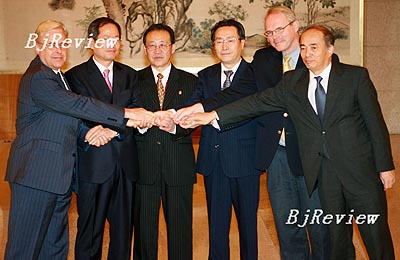|

Chinese officials like to use mountain climbing to describe the six-party talks aimed at resolving the North Korean nuclear puzzle.
In this sense, any step toward the peak-"the verifiable denuclearization of the Korean Peninsula in a peaceful manner"--is encouraging.
At the just concluded second phase of the sixth round of the multilateral talks, the Democratic People's Republic of Korea (DPRK) agreed to provide a complete list of its nuclear programs and disable its facilities at its main nuclear reactor by the end of the year, a "major step forward" hailed by officials and observers.
The fresh round of talks convened on September 27-30. After four days of "pragmatic and useful" negotiations, a joint agreement was hammered out and reviewed by all delegation members; then during a two-day recess on October 1-2, the document was taken back to the respective governments of related parties for approval. On October 3, the much-expected document was released.
According to the agreement, disablement of the DPRK's 5-megawatt experimental reactor, the reprocessing plant and the nuclear fuel rod fabrication facility, all located at Yongbyon, will be completed by December 31. A team of experts, led by U.S. scientists, will prepare for the disarmament process within two weeks after the joint was unveiled.
Before this, two agreements were reached on September 19, 2005, and February 13, 2007, respectively. Accordingly, the DPRK pledged to abandon all its nuclear weapons and disable all its nuclear programs in return for 1 million tons of heavy fuel oil from other parties involved and U.S. security guarantee.
UN Secretary General Ban Ki Moon said he was encouraged by the October 3 agreement achieved through multilateral diplomatic efforts. The Bush administration also "welcomed" the agreement, saying the document mapped out additional steps toward the "ultimate goal of full and verifiable denuclearization" on the Korean Peninsula, according to Xinhua News Agency.
Jin Xide, a world affairs expert at the Chinese Academy of Social Sciences, said the latest achievement is mostly a result of mutual understanding between the DPRK and the United States.
Washington is "desperately in need of a breakthrough" in terms of relations with Pyongyang, out of consideration for President George W. Bush's diplomatic legacy and the Republicans' prospects in the 2008 presidential campaign; meanwhile, the DPRK correctly comprehends U.S. demands, said Jin, adding the joint agreement is based on "privity" between the two sides.
China's efforts also led to the fruition of the talks, observers say.
After the newest round of talks, U.S. Assistant Secretary of State Christopher Hill spoke highly of China's "excellent role" as host of the six-party talks.
The talks, which involve the DPRK, the United States, China, the Republic of Korea (ROK), Japan and Russia, is regarded as the most effective vehicle to resolve the North Korean nuclear issue.
Pan Xiaoying, a long-time observer of the six-party talks from China Radio International, said all parties should march toward the goal of denuclearization, now that a clear timetable has been set.
Though the six parties reached a "satisfying" agreement, all parties need to strictly abide by and take concrete actions to really implement the agreement, said Pan.
|
Major Points of the Joint Agreement
I. On Denuclearization of the Korean Peninsula
1. The DPRK agreed to disable all existing nuclear facilities subject to abandonment under the September 2005 Joint Statement and the February 13 agreement.
2. The DPRK agreed to provide a complete and correct declaration of all its nuclear programs in accordance with the February 13 agreement by December 31.
3. The DPRK reaffirmed its commitment not to transfer nuclear materials, technology or know-how.
II. On Normalization of Relations Between Relevant Countries
1. The DPRK and the United States remain committed to improving their bilateral relations and moving toward a full diplomatic relationship.
2. The DPRK and Japan will make sincere efforts to normalize their relations expeditiously in accordance with the Pyongyang Declaration, on the basis of settlement of their unfortunate past and outstanding issues of concern.
III. On Economic and Energy Assistance to the DPRK
In accordance with the February 13 agreement, economic, energy and humanitarian assistance up to the equivalent of 1 million tons of heavy fuel oil (inclusive of the 100,000 tons of heavy fuel oil already delivered) will be provided to the DPRK.
IV. On the Six-Party Ministerial Meeting
The Parties reiterated that the six-party ministerial meeting will be held in Beijing at an appropriate time and agreed to hold a heads of delegation meeting prior to the ministerial meeting to discuss the agenda for the meeting.
Source: www.xinhuanet.com | | 